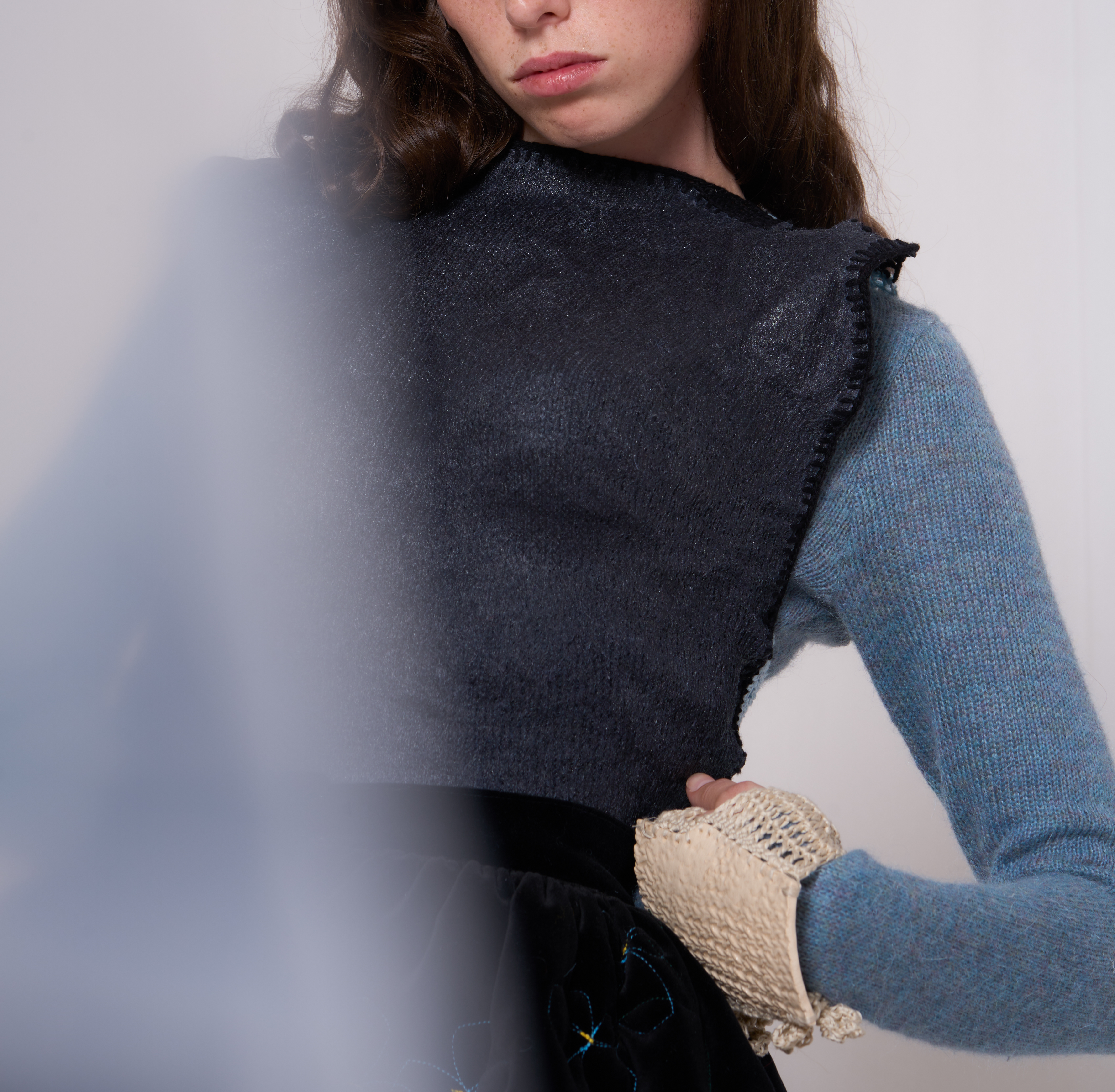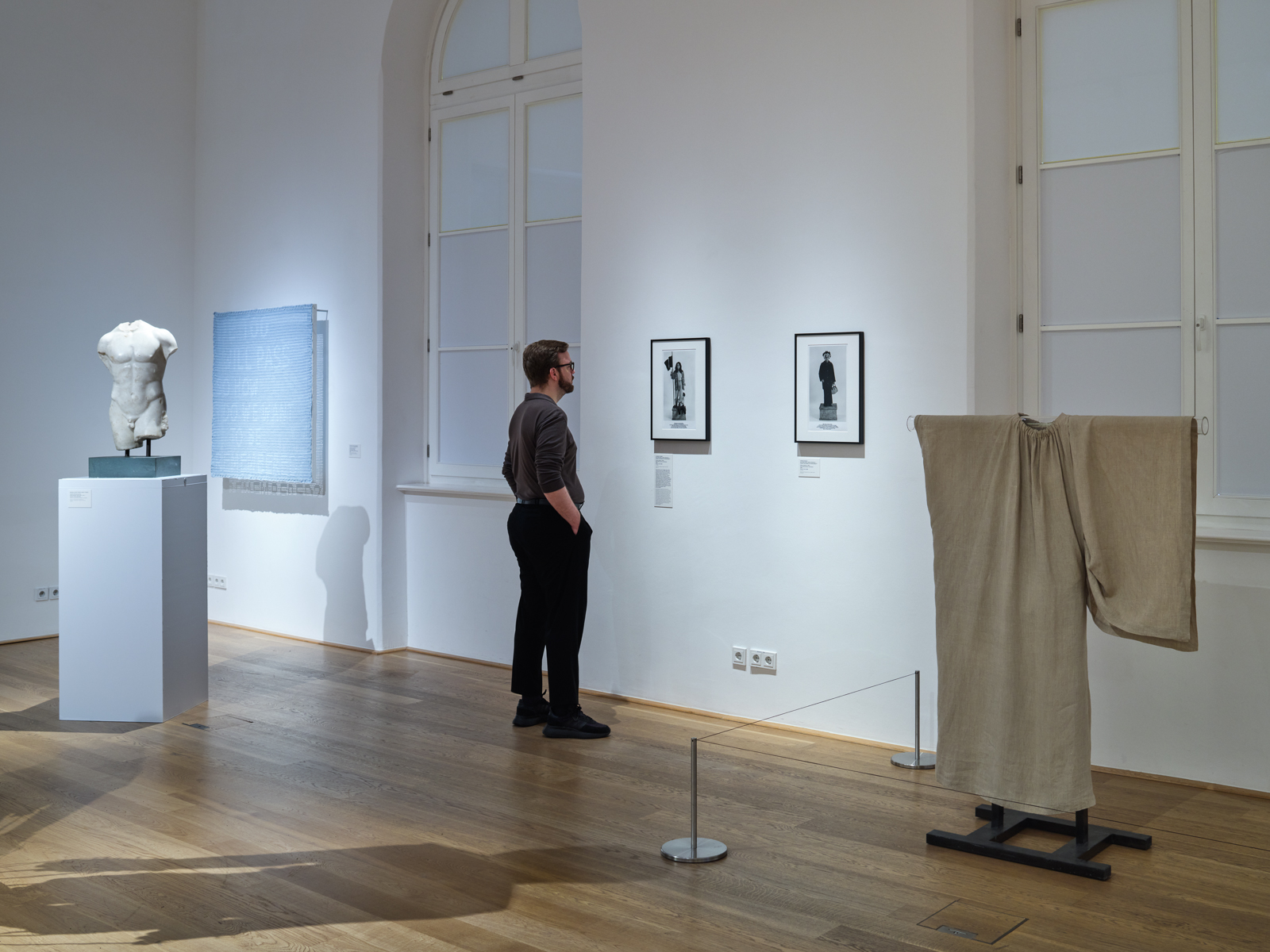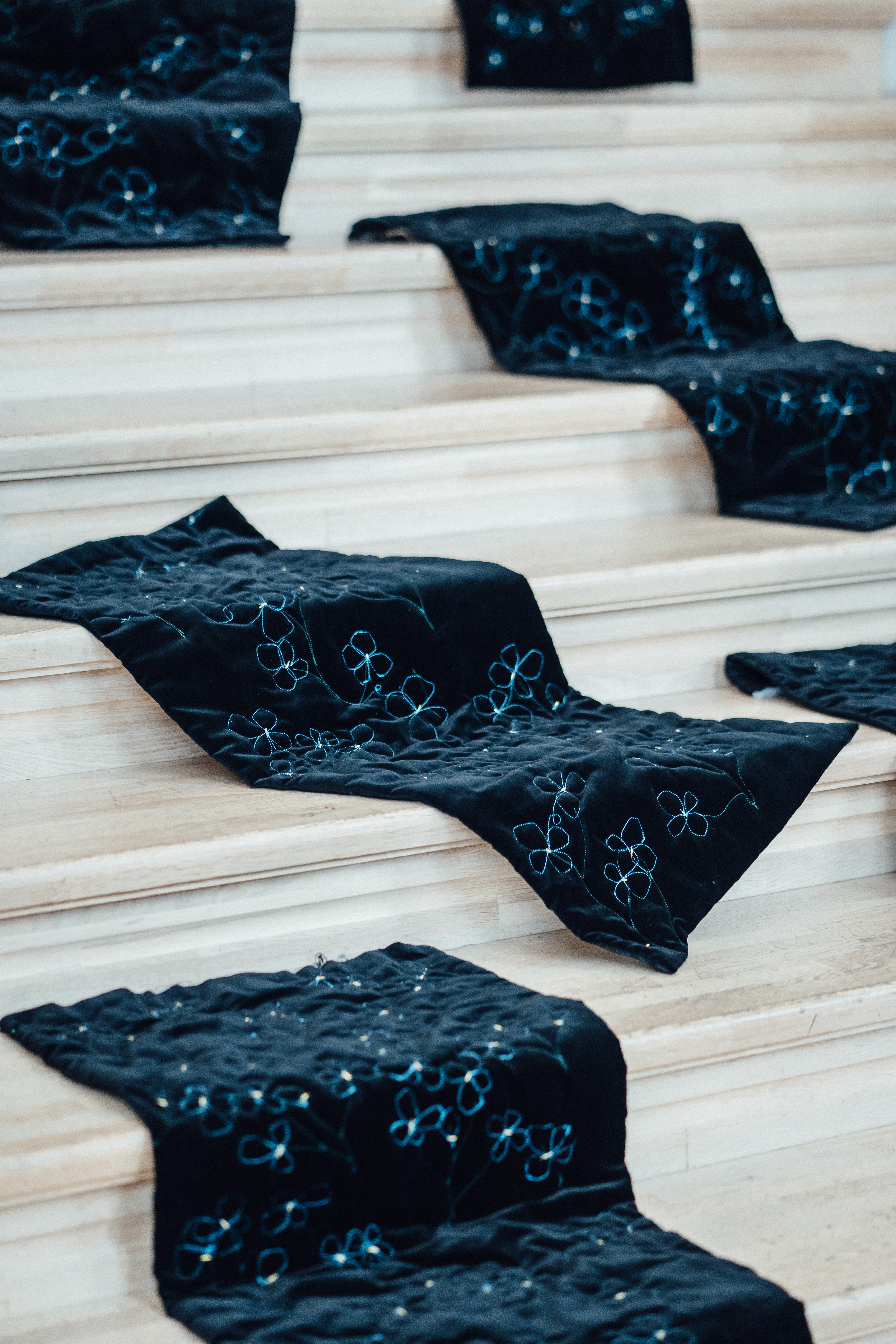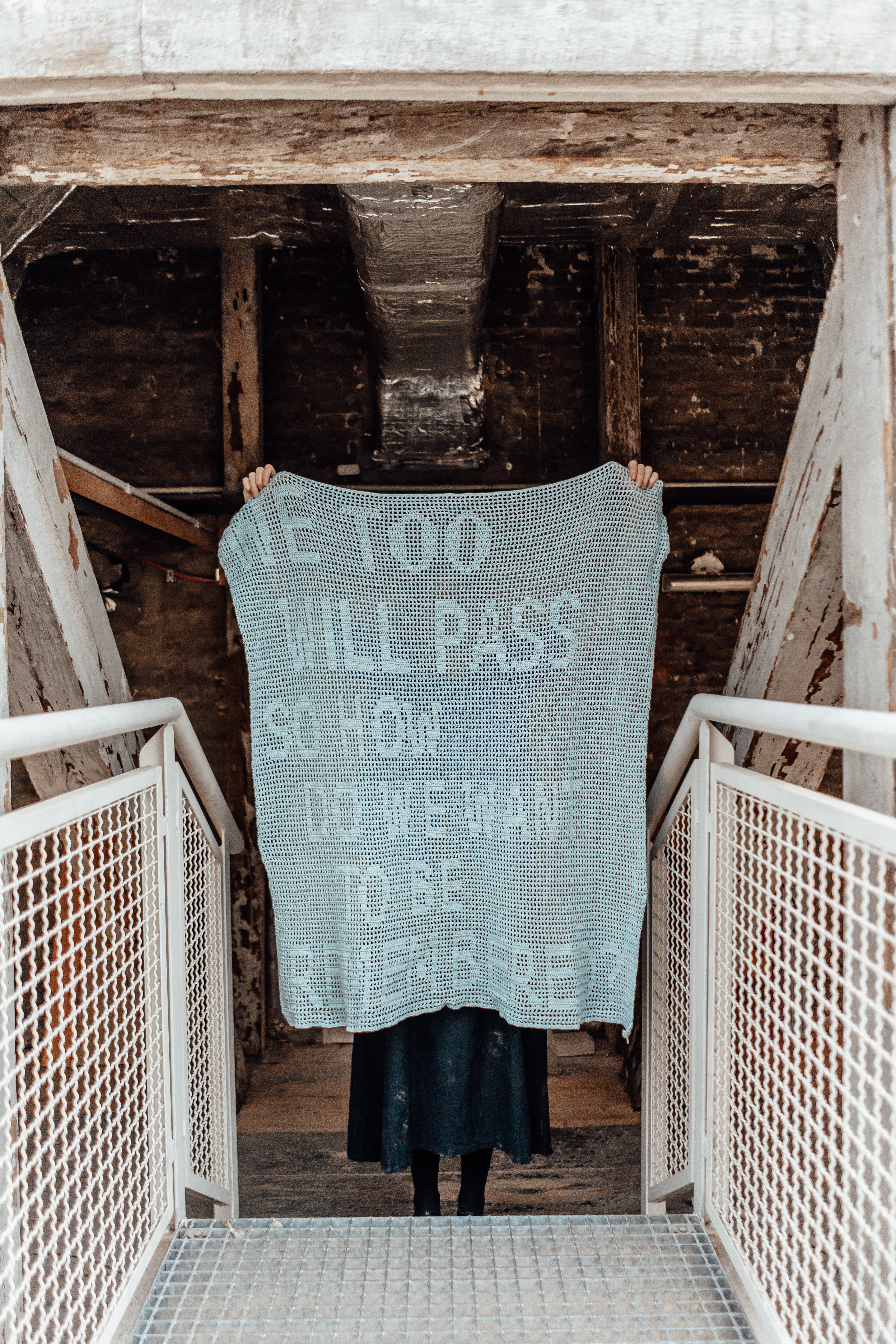Forget Me Not




The exhibition Forget Me Not and the purchase of a whole body of work by Stiftung Hamburger Kunstsammlungen for the MK&G collection marks a milestone within my artistic practice. I am very grateful for the opportunity.
In the exhibition “Forget Me Not” at the MK&G, the designer explores varied forms of memory culture – ranging from monuments to personal symbolic trinkets to dynamic textile objects – to question why and how we choose to hold onto certain memories. She makes the ambivalences inherent in the forms taken by such tokens of remembrance visible by combining opposing fabric properties and thus creating an ambiguous materiality: Ceramic imprints of body parts recalling the striving for immortality embodied by antique marble busts are encased in finely spun thread; crocheted textiles and flowing wool fabrics propose an abstract alternative to the “knot in the handkerchief”; and delicate forget-me-not embroidery is nearly absorbed by black velvet. “I plead for a mobile, social form of memory that embraces impermanence, as opposed to a society that tries to manifest itself as eternal through its commemorative objects, resisting the passage of time and mortality,” the designer explains. In addition to newly created works, the exhibition also features objects from the MK&G collection, including for the first time the series “Mein Denkmal” (My Memorial) by photographer Bettina Flitner (b. 1961) as well as fashion photographs by F.C. Gundlach (1926–2021), a four-faced wooden head as a memento mori (c. 1650), and intricately woven objects made of human hair (Hamburg, c. 1800–1850) as personal mementos of the deceased.
Collection

Memory cultures show us how societies represent themselves and how they want to be remembered. Forget Me Not asks with which intention and what sort of objects a culture shapes its own memory and legacy. The body of work consists of textile works with unusual material properties: ceramic body parts that appear to be knitted, crochet textiles and softly knitted wool fabrics. ‘Forget Me Not’ reveals differences between how objects cultivate our memory. There are, for example, personal objects, like a knotted hair brooch to commemorate a loved one. But also objects that express the memory cultures of societies that try to overcome their own mortality through static self-representation. This tension is used by Spitz as a starting point for her own fashion designs, in which she explores the possibility of a transformative memory culture. Transience should, according to Spitz, no longer be conceived of a threat. She invites us to reflect upon existing memory cultures from a feminist and material-oriented perspective.






Fragments of the thoughtprocess from the designer about ‘Forget Me Not’:
(Hamburg, 2023)
(Hamburg, 2023)



‘What shape do we give to our memory objects? With what intention and what implications? What does the materiality of our memory culture tell about us human beings at a specific moment in time and space? How does our memory look like in the past, present and future? How can we impact the way it feels, smells or behaves?’

‘An ‘empire’ wants to carve its ideal image in stone and to resist the constant threat of decay. The equestrian statue is static, militaristic and, in practice, often male. An empire and its objects scream in my face. Remember me exactly like this – forever. But above all it, the ‘empire’ culture of remembrance, acts, as if it could stage and manifest itself as eternal. Ich bin die Ewigkeit. I am eternity. I do understand this desire and striving for eternity well. And I understand the desire to carve myself in stone. Because then I will be remembered. Have control over my legacy. For a long time.


‘Imagine a picture of hair, a knot in your handkerchief or trimmings on your belt. And imagine, in contrast, an ideal body carved in marble, or equestrian statue. Both are ways in which we explicitly give form to our memory and use a particular materiality and symbolism.’


‘But my stitches are fragile, my stitches are impermanent and at the same time they are mobile, moving with time, able to acknowledge impermanence. A culture of remembrance that manages to put a broken thing back together. That would be a good culture of remembrance that manages to create something new that is linked with the old and at the same time creates something genuinely new. ‘


‘The ‘empire’ type of memory object is static and will break because it cannot move with time. But of course it will stay in the world longer than, for example, textiles. But it fails to acknowledge that it will eventually break. And it will break for sure. And then it can no longer follow the movement of time. Then it falls out of time, falls from the world.’

‘Forget Me Not reveals another aspect. Our will to manifest as eternal communicates to our fellow human beings. So the ‘empire’ idea of remembering reveals a notion of manifestation of status in the present.’
Bigger than life, bigger than anything.

‘I am imagining a more textile, flexible shape of memory. Is the form in which we remember and want to be remembered unchangeable? Is our memory formally and symbolically carved in stone to create an ideal image against time? Or is there the possibility of re-composing our forms of remembering, in the literal sense of the word [re]member?’

The desire is human and present. But it is also aggressive. I am not comfortable with this. I don’t want this.’

‘Marble, stone, hard, cold - these characteristics have a huge tension with everything that I otherwise find thematically or formally inspiring. It was exactly this moment of tension that I hoped for. From a tension like that, I can work.’
![]()
‘What is considered a monument? What is the purpose of a monument or memorial? How about the representation of people in our public spaces who are not white and male? And what are the bodies we depict?’
![]()
‘My time is a different time and my society is a society in which there are not only militaristic white men on horses. My time is a threatened time, threatened like any other time - by decay. Maybe my time is confronted with this fragility and threat of decay more and sooner. Our world is falling apart.’
![]()
![]()
‘On this same page we find the reason for the fetishization of youth in contemporary fashion. We do not want to see old bodies, as we don’t want to be confronted with this constant thread of decay. So we fetishize youth and youthful bodies - and call it fashion. I call it agesim.’

‘What is considered a monument? What is the purpose of a monument or memorial? How about the representation of people in our public spaces who are not white and male? And what are the bodies we depict?’

‘My time is a different time and my society is a society in which there are not only militaristic white men on horses. My time is a threatened time, threatened like any other time - by decay. Maybe my time is confronted with this fragility and threat of decay more and sooner. Our world is falling apart.’


‘On this same page we find the reason for the fetishization of youth in contemporary fashion. We do not want to see old bodies, as we don’t want to be confronted with this constant thread of decay. So we fetishize youth and youthful bodies - and call it fashion. I call it agesim.’
‘Looking at fashion and its striving to manifest itself as eternal makes this great tension most exiting! Because of the great paradox between fashion and eternity. Isn’t fashion actually like constant change? Or should we believe the great fashion empires that do try to stage themselves as eternal? Let’s remember the dialogue between fashion and death (Giacomo Leopardi, 1824), let’s think of fashion theories that clearly show that fashion, as a system and favorite child of capitalism (Werner Sombart, 1902), is constantly fueling itself more and more so it has to change ever faster. We live this kind of fashion for a variety of economic, psychological and sociological reasons. One of them, I believe, is that we always want the younger, newer and fresher because at the end of the day we don’t want to be confronted with the inevitable decay of everything. We refuse to acknowledge impermanence because, ultimately, we don’t want to confront our own mortality.’
Fragments of the thoughtprocess from Katharina Spitz
(Hamburg, 2023)
(Hamburg, 2023)
Forget Me Not
Exhibition

Memory cultures show us how societies represent themselves and how they want to be remembered. Katharina Spitz asks with which intention and what sort of objects a culture shapes its own memory and legacy. On show are textile works with unusual material properties: ceramic body parts that appear to be knitted, crochet textiles and softly knitted wool fabrics.



‘Forget Me Not’ reveals differences between how objects cultivate our memory. There are, for example, personal objects, like a knotted hair brooch to commemorate a loved one. But also objects that express the memory cultures of societies that try to overcome their own mortality through static self-representation. This tension is used by Spitz as a starting point for her own fashion designs, in which she explores the possibility of a transformative memory culture. Transience should, according to Spitz, no longer be conceived of a threat. She invites us to reflect upon existing memory cultures from a feminist and material-oriented perspective.





As part of my six month residency at the MK&G in Hamburg I was asked to develop a new work and exhibition for the Museum and ultimately the museum collection, on the basis of my experience of the latter.
I chose to curate an exhibition with objects from (almost) every collection the museum offers as a context to my new body of work Forget Me Not. The objects I curated with my new work show the tension I was designing from. I am grateful, among others, for the works by Hans Hansen, Rei Kawakubo, Yves Saint Laurent, F. C. Gundlach, Schiaparelli, Doerte Eissfeldt and especially Bettina Flitner. Her series 'My Monument' touched me deeply and triggered me to set off on the path leading to 'Forget Me Not'.
Building my exhibition and rooting my new work in the context of these amazing works has been an honor.

Forget Me Not
PROCESS












All Images by Alisa Reutova
Copyright / Concept / Design / Crafting Katharina Spitz
Talents: Kadija Cham, Elisa Sophie Wedmann, Lene Wittkamp, Amelie Frischbier
Agencies: Modelwerk, SPIN Modelmanagement
